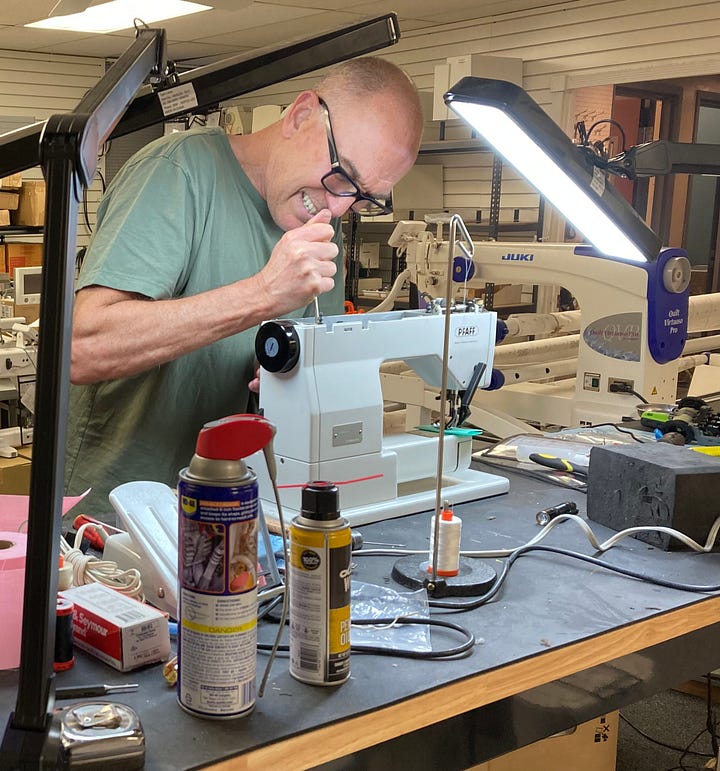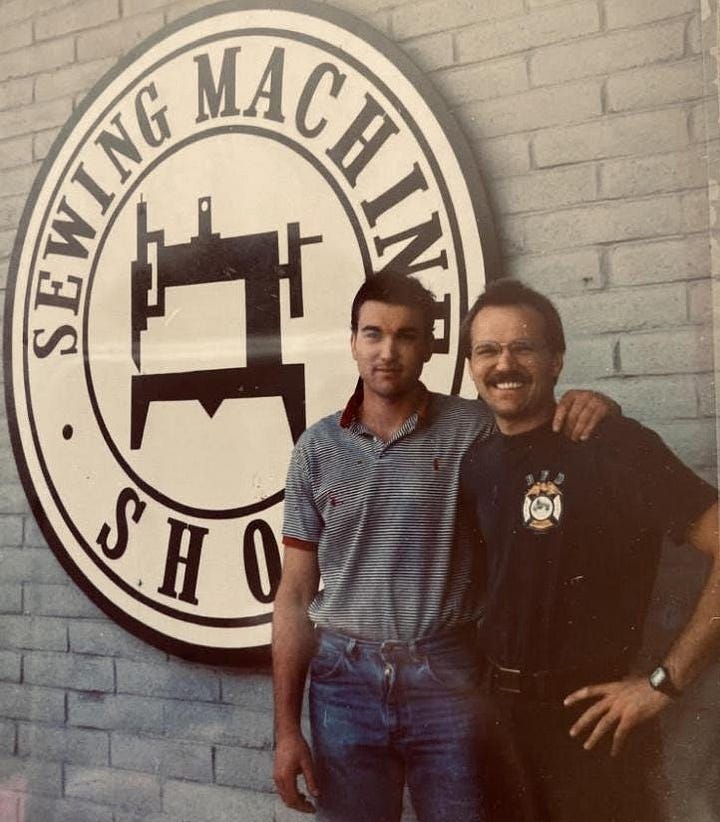The Facts and Myths of Sewing Machine Lubrication
Introducing a New Contributing Writer to The Sewing Machine Newsletter
Greetings everybody,
I am excited to announce that a second contributing author will be joining The Sewing Machine Newsletter: my father, Dan Schoenberg.




My dad has over 30 years of experience in the sewing machine world, both as a technician, salesman, and business owner. He is a wealth of knowledge when it comes to sewing machines, as well as one of the most honest and intelligent people I know. If you like the articles I have been writing, then you will like his even more, for I am merely attempting to do my best impression of my dad. Now you can get the information straight from the horse’s mouth.
My dad has agreed to write one article per month, all of which will be exclusive to paid subscribers. So, in addition to the free articles published weekly, paid subscribers will now have access to all of his posts (1 per month) and all of my paid posts (1-2 per month). Only $5/ month or $60/ year. Perhaps my Uncle Marty will soon start contributing as well.
To give you a clearer idea of my dad’s depth of knowledge, I have posted his first article in complete entirety, which covers the topic of sewing machine lubrication. We hope you find it helpful.
The Facts and Myths of Sewing Machine Lubrication
by Dan Schoenberg
There are so many different perceptions on where, how often, and how much an owner should apply lubrication. In this article I will clarify once and for all the facts about oiling and dispel many of the myths that I hear. Almost every day, I observe both a lack of lubrication and severe over oiling.
As a general rule, I tell sewers "You should apply the smallest amount of oil (1 drop) possible to the critical areas on your machine often, instead of applying a lot of oil everywhere once a year. Over-oiling has the consequence of staining your fabric. As gravity takes effect, the oil will make its way down toward your project. On modern sewing machines over oiling can spray on electronic components such as circuit boards and sensors.
Oiling the Sewing Hook:
We do not use grease at all in our service dept. and neither should you. You should only use very light sewing machine oil. This oil is clear and should look almost like water. DO NOT use 3 in 1 oil, Teflon lubricants, or WD40. We have seen these lubricants gum up or harden over time. We also sell the same oiler that we use in our service dept. It is fantastic for getting to tight spots and for only dispersing 1 drop at a time. Proper oil and oiler are a great inexpensive investment.
On modern machines, there are few places the owner can gain access to oiling spots, but they can always gain access to the sewing hook. The sewing hook is the most critical area to lubricate. It is the source of the most noise, friction, and wear. Different machines have different styles of hooks. Bernina and Pfaff machines have different hook designs, but both machines have metal on metal hook systems that require a drop of oil every 8 sewing hours. Before oiling these hook systems, it is important to clean the "hook race" prior to applying your drop of oil. Very few sewers know how to identify the hook race and more times than not put too much oil on an area that is incorrect and basically useless. Almost all top-loading machines with drop-in bobbins (Janome, Brother, Singer, Baby lock) have plastic bobbin cases that ride on metal hooks. Oiling is not as critical, but still could be done for the same reasons as metal on metal. If you are unsure of where your hook race is located on your sewing machine, please come in and let us show you. Keeping your hook lubricated properly will keep your machine quiet and reduce wear caused by friction.
Other Oiling Areas:
Your ability to oil other places on your machine will depend on access. Older machines allow you to gain more access. As a general rule, oil should be applied to any areas that you see metal on metal movement. Such areas are where moving shafts go through stationary bushings (bushings are like tunnels that the shafts go through). If you can open your side cover, you can oil the needle bar, presser bar, and needle threader shafts. If you can gain access to the underside, you can oil the hook drive shaft. If you can gain access to the top of machine, you can oil the top shaft and take-up linkages. Remember only 1 drop. Do not drop oil into places you cannot see. On sergers, the critical area is the upper looper shaft. Refer to your owner's manual for oiling and cleaning guidance.
Remember that you still will want to get your machine professionally serviced. We split the cases on the machine to gain access to places that you cannot get to. Also, we know of the critical areas to pay attention to that are specific to each make and model. If you are an everyday sewer, I suggest service once per year. If not, I would say every 2-3 years.
-Dan Schoenberg






Great video! Thank you for the information and the demonstration.
I am 79 years old widow. Thanks for this message. I have been using a different Singer since I was 9 years old. First, the neighbors treadle, then the electric singer at school. Then my Grandmothers' electric motor added treadle, and finally my Singer in the mid-sixties. I was in the country and did not have a service center. These articles explain why I had many problems and no one to answer them. Wish it were afffordable to get the upgrade.